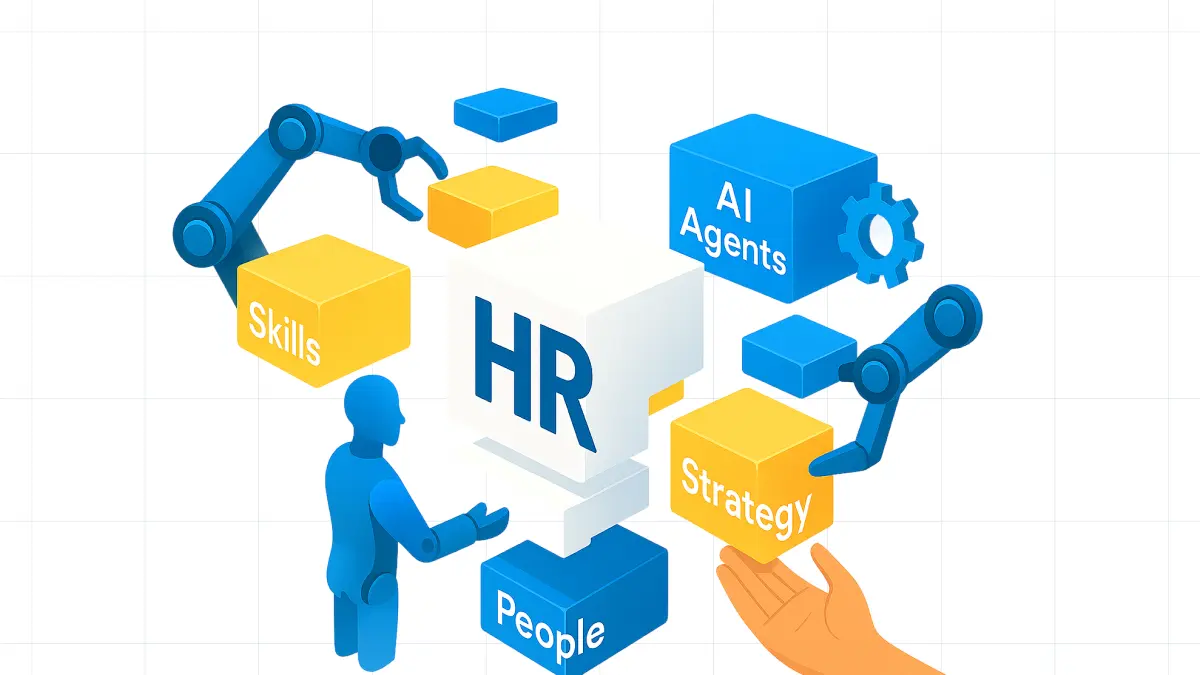The future of organizations is one with an increasing focus on data.
As Suzy's Chief People Officer Anthony Onesto told me in a recent interview:
"In this day and age, you have to be analytics-focused. And the best scenario is to have all data in one place." – Anthony Onesto, Chief People Officer, Suzy
This means that choosing the right HRIS Software is key for organizations to thrive.
So, what is an HRIS in 2024? And what should you be thinking about when assessing your options?
I'll give you an executive summary of all you need to know, below.
What is an HRIS?

The HRIS, or Human Resources Information System, is your central "People Operating System," focused on housing and managing employee data and extending to payroll, benefits, and performance management.
An HRIS is one of the most important HR Software tools as it is the foundation of your HR tech stack.
The HRIS you choose is also key to the employee experience, as your teams will interact with it frequently for PTO requests, pay stub downloads, and other HR self-service tasks.
For these reasons, choosing the right HRIS will also improve your HR team's lives significantly as they can automate workflows, spend less time answering questions, and spend more quality time with individual employees.
For more, see my guide HRIS Meaning, How to Choose HR Software and our picks for the best modern HRIS Software.
Why does an HRIS Matter?

With its capability to store and manage essential employee data, including personal details and employment-related information, HRIS is the backbone for most HR functions, from recruitment and onboarding to performance management and benefits administration.
A good Human Resources Information System expedites tasks, reduces manual efforts, ensures compliance, and secures data.
Plus, your HRIS could help you make more data-driven decisions around promotions, performance improvement plans, and broader workforce planning.
Some of the key features that the right HRIS system contains include:
- Employee Data Management: Maintains comprehensive records of employee information.
- Benefits Administration: Manages employee benefits packages efficiently.
- Payroll Processing: Automates salary calculations and distributions, with newer HRIS solutions like Deel, Rippling, and Gusto doing so for global and remote teams.
- Time and Attendance Management: Tracks employee work hours and attendance.
- Reporting and Analytics: Provides insights into HR metrics and data for informed decision-making.
- Employee Self-Service: Empowers employees to manage their personal information and requests.
According to BambooHR research, the right HRIS can save HR professionals up to 2 hours per day on administrative tasks by automating these essential HR functions.
This helps the shift from administrative to strategic HR functions, putting Human Resources at the core of organizational success. Which is, in our view, where HR belongs.
Benefits of the right HRIS
Hopefully, what I have shared so far has helped you build a mental model of why the HRIS matters beyond employee administration.
This category of Employee Management Software has been evolving rapidly over the past years.
Newcomers like Rippling, Deel, Gusto, Lattice, and BambooHR have slowly but surely removed the image of an HRIS as an admin platform, instead showcasing it as the thriving heart of your people operations.
Some of the benefits of switching to a modern HRIS that brings you into the 21st century and delights your employees and HR teams are:
Streamlined Processes and Increased Efficiency:
Modern HRIS solutions automate routine HR tasks like payroll, time tracking, and benefits administration, reduce manual errors, and boost overall productivity.
Centralizing HR data and processes in one place can additionally lead to significant cost savings.
Enhanced Decision-Making:

Real-time reporting and analytics capabilities provide valuable insights into workforce trends and performance metrics, enabling informed decisions and strategic planning.
Going back to Anthony's quote, as data is the lifeblood of any modern organization, having live data at your fingertips ensures a future-proof organization that can adjust to rapidly changing market circumstances in an agile manner.
People analytics will increase in importance as you and every organization need to optimize and improve in increasingly shorter cycles to be competitive.
Improved Employee Experience and Organizational Culture:

Your team is interacting with best-in-class apps and software daily.
Whether it's a Gen Z'er spending too much time on TikTok or a Millennial interacting with the world through Instagram, Venmo, and Gmail, not to mention ChatGPT, expectations are high.
You don't want them to feel that interacting with your company is an unpleasant trip down memory lane.
The right HRIS software is designed for a positive employee experience and includes a streamlined interface, social features, and peer recognition capabilities, fostering a more engaged company culture.
Automating mundane processes such as onboarding and reviews, for example, with the use of Generative AI, additionally brings HR software in line with expectations.
And as we see our people less in remote and hybrid work settings, we need to seize all opportunities to strengthen our company culture.
Improved Compliance:
Rules and regulations change all the time.
This makes effectively managing teams challenging, especially so far with the increasing number of companies that practice remote work or otherwise hire global talent.
The good news is that many modern HRIS platforms have been built with global hiring.
Automated updates in response to changes in legislation ensure compliance with regulatory requirements, reducing the risk of non-compliance and associated penalties.
New players in the field of HRIS like Deel even have combined Employer of Record services and core HRIS software.
For more, see my detailed guide on the benefits of HRIS.
HRIS, HCM, and HRMS

Many overlapping and confusing terms describe HR software, particularly the acronyms HRIS, HRMS, and HCM.
But in reality, these are distinct platform categories that are relatively easy to separate:
HRIS
Firstly, HRIS stands for Human Resources Information Systems.
These platforms are designed to manage core HR functions such as payroll, benefits management, time tracking and reporting, and employee self-service.
Most companies have HRIS software in place to streamline their HR processes.
HRMS
Moving on, HRMS stands for Human Resources Management Software.
This type of software encompasses all of the features found in HRIS but includes additional functionalities that directly impact the employee experience.
These additional features may include performance management tools, succession planning capabilities, and employee onboarding resources.
HRMS software usually aims to enhance employee experience and improve efficiency by incorporating these elements.
HCM

Lastly, we have HCM, which stands for Human Capital Management.
HCM is considered the most comprehensive set of platforms available, although due to its extensive capabilities, it is often out of reach for startups and SMEs.
In addition to the features found in HRIS and HRMS, HCM also includes ATS Software, Training and Development tools, and Expense Management functionalities.
This integrated approach to workforce management is typically leveraged by larger enterprises seeking a holistic solution.
Popular platforms include Workday, SAP SuccessFactors, and Oracle HR Cloud. They're among the most-cursed workplace technology, but in a way, that's hard to avoid for platforms that have to service massive companies across many geographies.
For a deeper look, see my guide on HRIS vs HCM.
Comparison: HRIS vs. HRMS vs. HCM:
HRIS, HRMS, and HCM each offer unique features and functionalities that cater to different organizational needs.
The table at the top of this section explains the differences between these human resources systems well.
HRIS Platforms to Consider
Which HRIS platform fits you best ultimately depends on several questions, as I share in the section below.
Regardless, a few innovative vendors stand out as great choices for the type of people-centric organizational leaders that usually read FlexOS:
Rippling

Rippling is a fairly new HRIS launched by the founder of Zenefits.
It's a great choice for scaling remote companies that want one system for HR, Finance, and IT.
Rippling is unique in that it truly is a complete People Operating System, handling everything from payroll to performance reviews to delivering employees' laptops.
And, it does this for all your employees and contractors, no matter where in the world they are.
BambooHR

BambooHR is a very user-friendly HRIS that's perfect for SMBs and lower-complexity companies choosing their first HRIS.
BambooHR integrates all HR functionalities into a single platform, creating a one-stop shop for managing the employee lifecycle—from hiring and onboarding to payroll, benefits, and offboarding.
Gusto

Gusto brings startups, scale-ups, and SMBs a great HRIS that does global payroll well.
Many HR leaders I've spoken to say that Gusto beats competitors like Trinet HR and ADP because of its ease and cost-effectiveness.
Users also highlight the great customer support crucial for successful HR operations.
For more, see our detailed guide to the best HRIS software.
Choosing the Right HRIS for Your Business
So now that we know what an HRIS is and what the many benefits of the right HRIS software are, the question obviously follows: how to choose the right one for us?
You can read my detailed guide on how to choose HR software, but in short, these are the steps to take:
1. Understand Your Needs
Identify both current HR challenges and anticipate future growth or changes.
This step ensures that your newly chosen system can scale and adapt as your organization evolves.
2. Engage with Employees
Workweek Chief People Officer Hebba Youssef said it well: "What will excite my employees, a tool they want to use? Because if you're always forcing them, you're never going to see real adoption."
Gathering input from users across the organization helps ensure the selected system meets the diverse needs of all stakeholders, fostering a more inclusive decision-making process.
3. List Requirements

Develop a comprehensive list of features, categorizing them into 'must-haves' and 'nice-to-haves.' This aids in prioritizing the functionalities most critical to your operations.
Determine specific HR requirements and areas that could benefit from automation, such as payroll or employee data management.
Additionally, ensure that the new HRIS integrates seamlessly with your existing People Technology and IT infrastructure and can adapt to your organization's evolving needswhich are .
Finally, make sure you choose a scalable solution that can handle increasing volumes of employee data and additional functionalities as your business expands.
4. Set a Budget
Establish a budget that includes the purchase price, implementation, and ongoing maintenance costs.
More HRIS platforms now charge fees for 'premium' support, meaning you're otherwise relegated to finding answers in online knowledge bases and forums.
Many HR decision-makers I've spoken to say that immediate support makes or breaks the experience with an HRIS vendor.
5. Evaluate HR Suites vs. Standalone Tools

Consider whether a comprehensive HR suite or a combination of standalone tools better aligns with your organizational strategy.
This is a big decision, so consider integration capabilities and overall ease of use.
I see a trend towards the Suite approach, with Paper Chief People Officer Q Hamirani saying:
"Unifying communication mediums and service delivery is in the best interest of people leaders to push and fight for." – Q Hamirani, Chief People Officer, Paper
Hebba added in her interview with David Green:
"I have one system right now and I'm going to be very cautious before I implement anything else." – Hebba Youssef, Chief People Officer, Workweek
6. Consider AI
Explore how AI capabilities within your Human Resources Information System can automate routine tasks, provide analytics for decision-making, and enhance the overall employee experience.
As AI platforms globally receive over 3 billion visits per month, ensuring that your new HRIS system isn't outdated by the time you've finished implementing it is key.
The Role of AI in HRIS Systems
Speaking of AI:
Besides becoming an expectation from employees not to take manual action on items they know AI can do, AI can fuel your HRIS system in many ways.
Below are a few areas where AI will play a major role.
Advanced Data Processing and Analysis
AI-powered HRIS systems utilize sophisticated algorithms and machine learning capabilities to sift through and analyze extensive datasets, identifying patterns and trends that inform strategic HR decisions.
We see this especially in skills platforms like Eightfold and Gloat, which are heavily featured in our Top 40 AI in HR.
This enables your HR teams to harness data-driven insights for recruitment, performance management, and employee engagement strategies.
Recruiting Faster and With Less Bias

One key area where AI is impacting HR is recruiting: of the 40 top AI HR tools, 38% are AI recruiting platforms.
This is unsurprising, as bots are helping individual job seekers apply for up to 750 jobs per day – HR needs AI to tackle mass recruiting challenges.
AI Recruiting Software like Textio, Fetcher, and Paradox help companies automate the recruiting process so recruiters can spend more time with the most promising candidates.
Interestingly, this doesn't just help companies: it also massively improves the candidate experience, as AI can shorten the often lengthy recruiting process by weeks.
For more, check out our our Top 6 Picks of AI Recruiting Software.
Enhancing Employee Experiences and Efficiency
By leveraging employee data, AI crafts personalized experiences, significantly boosting engagement, satisfaction, and productivity.
We see this for example in Desk Booking Software, where platforms like Robin and Flexy.AI tap into AI to give personalized recommendations about when to come into the office and where to sit, with the intent to enrich the employee experience and culture.
And HRIS platforms will most likely not fall behind. Walmart Chief People Officer Donna Morriss highlighted in an interview how employees soon will be 'talk' to their HR applications for many common tasks.
Automated Routine Tasks
AI-driven chatbots automate routine HR tasks, including responding to employee inquiries and managing leave requests.
This frees up your HR organization to focus on more strategic initiatives.
This kind of AI-powered self-service brought platforms like Leena and Moveworks to the top of our Top 40 AI in HR list.
Real-time Performance Evaluations

Moving away from traditional annual reviews, AI algorithms enable real-time, data-driven performance assessments, offering comprehensive insights into employee performance.
Platforms like Textio and OnLoop can take short notes on performance and turn them into well-written, unbiased performance reviews (ushering in an entirely new generation of Performance Review Software.)
Customized Learning Platforms
AI tailors training and development plans to individual employee needs, promoting skill development and career growth.
Sana, for example, has impressed me tremendously with opportunities for highly tailored learning content in the flow of work.
For more, see our detailed Top 40 AI for HR Tools.
HRIS Platforms Embracing AI

While AI clearly has a lot of potential for HRIS platforms, not every provider has embraced the technology.
Platforms like Workday HRIS seem to be all in on AI. As their CEO Carl Eschenbach shared:
"The output of your AI is only as good as the data you're putting into it in the data model when you think about Workday our data is highly curated it's 65 million users on a common platform and that's where we're training our AI model off of so it's very secure it's protected, highly curated so it's very different than do an AI where you're training off the internet so I think we are different in how we think about it." – Workday CEO Carl Eschenbach
Competitors, like the otherwise very innovative Rippling, who's founder Parker Conrad said they'll take it slow on AI:
"We are a company that is relatively free of any AI products right now. There’s some stuff that we’re working on. But I am always very skeptical of things that are, like, super trendy in Silicon Valley." – Rippling founder Parker Conrad
As AI will play an important role in how we manage our people and companies, ensure you consider your HRIS' providers approach to integrating this new technology.
For more, see my in-depth review of AI in HRIS platforms.
Maximizing the Value of HRIS Data

Data, data, data.
Yes, I'm fully aware that data is a repeating topic in this article. And for good reason.
Maximizing the value of HRIS data goes beyond just collecting and storing it.
The right HRIS turns data into actionable insights that drive strategic HR decisions and enhance the employee experience.
Here's how:
Customization and Continuous Improvement:
Customize your HRIS, including key dashboards, to meet organizational needs and ensure it aligns with your specific HR goals and processes.
Then, continuously update the system to ensure it's aligned with new business targets, HR programs, and compliance requirements.
Ensure you also train HR teams and employees on extracting data that helps them in their daily activities.
Data-Driven Employee Experiences:
Utilize HRIS data to create personalized employee experiences and tailored learning programs that align with individual development needs and aspirations.
HRIS software that incorporates performance management modules, like BambooHR and HiBob, can help you connect employee engagement and development on a personalized basis.
Deeper People Analytics can uncover hidden patterns in employee data, aiding you in predictive workforce planning and strategic talent management.
Strategic HR Interventions:
The right HRIS will help you analyze employee turnover, engagement, and performance trends to identify areas for improvement.
It will allow you to develop personalized interventions for at-risk employees, enhancing retention and satisfaction.
The collaboration between HR and line managers is especially critical in leveraging HRIS analytics for informed decision-making and action-taking.
As the middle manager is more important than ever, removing barriers to data and insights here is hugely impactful.
HRIS Implementation Strategy

Crafting an effective HRIS implementation strategy is the foundation for its success, as well as the success of the overall HR technology strategy within your organization.
Here's a streamlined approach to ensure a smooth transition:
Preparation Phase:
- Define Main Objectives: Clearly outline what you aim to achieve with the HRIS implementation.
- Identify Data to be Stored: Establish the types of employee data your HRIS will manage.
- Specify Stakeholders' Roles: Clarify the responsibilities of each team member involved in the project.
Implementation Phase:
- Prioritize Modules: Start with essential features like employee information and payroll, then gradually add complex functionalities such as performance management.
- Estimate Implementation Time: Set realistic timelines for each stage of the implementation process.
- Schedule Regular Meetings: Keep all stakeholders informed and engaged through frequent updates and discussions.
Post-Implementation Phase:
- Training and Support: Provide comprehensive training sessions and materials to ensure users are comfortable with the system.
- Monitor and Optimize: Regularly assess system performance and make necessary adjustments to enhance efficiency and user experience.
- Stay Current: Keep the system updated with the latest features and security protocols to maintain optimal performance.
Adhering to these steps ensures a smooth launch or transition that maximizes the benefits of your new system.
Congratulations. You're now on your way toward a more employee-centric and data-driven organization, resilient to the many challenges and changes the future will hold.
The Bottom Line: HRIS Software

I wasn't kidding—the HRIS may sound like 'back office technology,' but in reality, it could be the backbone of a data-first, employee-centric approach to running your company.
A new and more modern HRIS will be foundational to operational efficiency and strategic HR management by automating routine tasks, enabling data-driven decision-making, and enhancing the overall employee experience.
Used appropriately, these systems are not just tools for administrative efficiency but are also catalysts for fostering dynamic workplace environments and promoting strategic growth, with humans at the core of all you do.
As we move beyond 2024, the importance of selecting, implementing, and maximizing HRIS systems will only continue to grow, underlining the need for businesses to stay ahead in human resources management.
If you need hands-on support in choosing a better HRIS, make sure you check out our guide to the top HRIS Software.
Frequently Asked Questions
Need a quick answer to the most common questions about HRIS? Here it is:
Q: What is an HRIS?
A: An HRIS (Human Resources Information System) is a centralized system for managing all HR activities, including employee data, payroll, benefits, and performance management.
It's essentially the core of your HR tech stack, crucial for enhancing employee experience and streamlining HR operations.
Q: Why is choosing the right HRIS important?
A: The right HRIS saves significant administrative time, ensures data accuracy, enhances compliance, and supports strategic HR functions like workforce planning and performance management.
It's also vital for improving the employee experience with your organization's HR processes.
Q: What features should I look for in an HRIS?
A: Key features include employee data management, benefits administration, payroll processing, time and attendance management, reporting and analytics, and employee self-service options.
Advanced solutions offer global and remote team management capabilities.
Q: How does an HRIS improve HR workflows?
A: By automating routine tasks, HRIS frees up your HR team to focus on strategic initiatives and spend more quality time with employees.
Automation also reduces errors and ensures compliance with changing regulations.
Q: What's the difference between HRIS, HRMS, and HCM?
A: HRIS focuses on core HR functions; HRMS includes HRIS features plus elements like performance management and employee experience tools.
HCM offers a comprehensive suite that includes HRIS and HRMS features as well as recruitment and talent management.
Q: How do I choose the right HRIS for my business?
A: Start by understanding your current and future HR challenges.
Engage with employees for input, list must-have and nice-to-have features, set a budget, and consider whether you prefer a comprehensive suite or standalone tools.
Also, evaluate the potential of AI in enhancing HR operations.
Q: Can an HRIS system handle global payroll and compliance?
A: Yes, modern HRIS platforms are designed to manage payroll and ensure compliance for global and remote teams.
They automate updates in response to legislative changes to minimize non-compliance risks.
Q: How is AI featured in modern HRIS systems?
A: AI can automate routine tasks, provide advanced data analysis for strategic decision-making, enhance recruiting processes, and personalize employee experiences, among other benefits.
While it's still early days for AI in the world of HRIS platforms, we can all expect to see more applications in 2024 and beyond.
Q: What steps should I follow for HRIS implementation?
A: Define your objectives, identify the data and stakeholders involved, prioritize modules, set a realistic timeline, provide training, and regularly monitor and optimize the system post-implementation.























